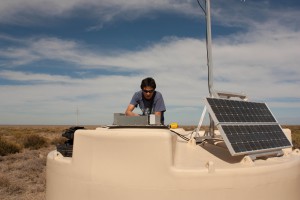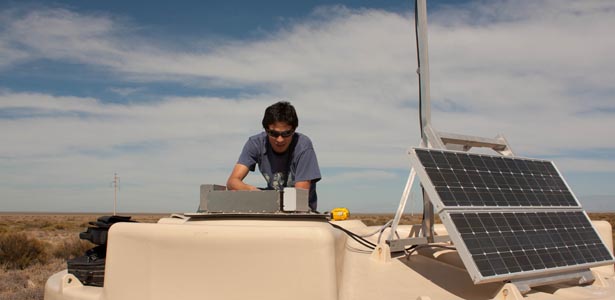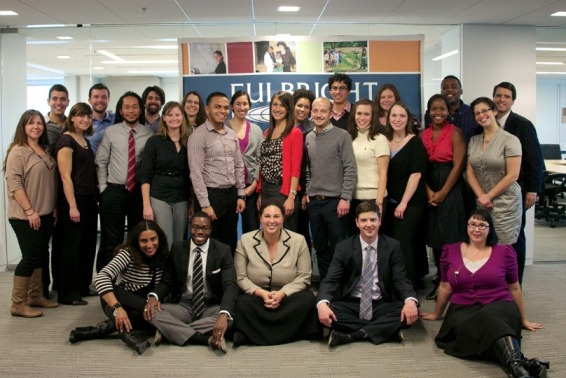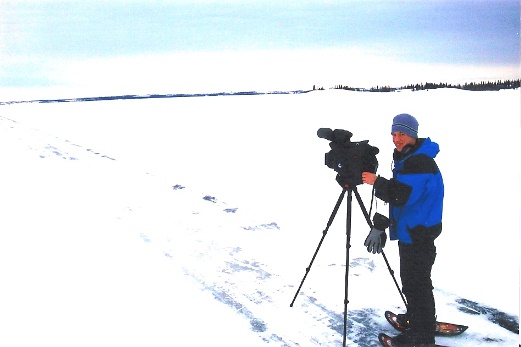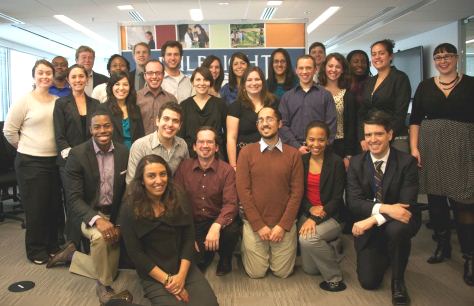
On Wednesday, February 29th, 21 newly selected Fulbright U.S. Student Program Alumni Ambassadors met in Washington, DC to receive training on how to promote and recruit for the Fulbright U.S. Student Program. Staff members from the U.S. Department of State’s Bureau of Educational and Cultural Affairs (ECA) and the Institute of International Education (IIE), along with Fulbright Alumni Ambassadors from the 2011 cohort, shared tips on giving an effective presentation and emphasized the unique, important role that Fulbright Alumni Ambassadors play in inspiring diverse students, Fulbright Program Advisers, college administrators – and anyone interested in the program – to learn more about it and the power of educational and cultural exchange.
The Fulbright U.S. Student Alumni Ambassador Program was established in 2008 to identify, train and engage a select group of approximately 15-25 Fulbright U.S. Student Program alumni to serve as representatives, recruiters and spokespersons for the Fulbright Program. They are selected annually through recommendations from Fulbright Commissions and U.S. Embassy staff, area managers, the Fulbright Student Program Outreach Division and approved by the sponsor of the Fulbright Program, the U.S. Department of State’s Bureau of Educational and Cultural Affairs. Fulbright Alumni Ambassadors come from an array of different ethnic and socio-economic backgrounds, states, fields of study, institutions and have participated in the Fulbright U.S. Student Program in all world areas.
Fulbright Alumni Ambassadors represent the program’s rich diversity and play a key role in increasing knowledge about Fulbright opportunities. They provide testimonials about their Fulbright experiences at conferences and campus presentations, and offer application tips in written articles, video and podcast interviews, webinars and at special events throughout the United States. The Fulbright U.S. Student Program relies on the Fulbright Alumni Ambassadors to share with potential applicants what the Fulbright experience is really like and how to successfully address the challenges of living abroad while meeting the Fulbright Program’s ultimate goal – to increase mutual understanding between the people of the U.S. and the people of other countries.
Here’s a preview of the 2012 Fulbright Alumni Ambassadors:
Sade Bonilla
Current City: Albuquerque, New Mexico
Undergraduate Institution: Brown University
Fulbright U.S. Student Fellow in Education – Chile, 2009-2010
Regina Cagle
Current City: Baltimore, Maryland
Undergraduate Institution: Drexel University
Fulbright U.S. Student Fellow in Energy – Ecuador, 2008-2009
Maya deVries
Current City: Berkeley, California
Undergraduate Institution: University of California, Davis
Fulbright U.S. Student Fellow in Biology – Panama, 2010-2011
Kristen Erthum
Current City: Washington, DC
Undergraduate Institution: Doane College
Fulbright English Teaching Assistant – Egypt, 2010-2011
Linnette Franco
Current City: Atlanta, Georgia
Undergraduate Institution: Agnes Scott College
Fulbright English Teaching Assistant – Spain, 2009-2010
Dustin Gee
Current City: New York, New York
Undergraduate Institution: Juniata College
Fulbright English Teaching Assistant – Montenegro, 2010-2011
Francesca Ioffreda
Current City: San Francisco, California
Undergraduate Institution: Claremont McKenna College
Fulbright U.S. Student Fellow in Economic Development – Colombia, 2010-2011
Jessica Kuntz
Current City: New York, New York
Undergraduate Institution: Georgetown University
Fulbright U.S. Student Fellow in Political Science – Croatia, 2010-2011
Samson Lim
Current City: Seattle, Washington
Undergraduate Institution: University of Washington
Fulbright U.S. Student Fellow in Education – Germany, 2010-2011
Eli Magana
Current City: Memphis, Tennessee
Undergraduate Institution: San Diego State University
Fulbright U.S. Student Fellow in Political Science – South Korea, 2009-2010
Regina Mamou
Current City: Chicago, Illinois
Undergraduate Institution: Rhode Island School of Design
Fulbright U.S. Student Fellow in Art and Architectural History – Jordan, 2009-2010
Antonio McAfee
Current City: Baltimore, Maryland
Undergraduate Institution: Corcoran School of Art
Fulbright U.S. Student Fellow in Photography – South Africa, 2009-2010
Fareed Mostoufi
Current City: Washington, DC
Undergraduate Institution: New York University
Fulbright English Teaching Assistant – Argentina, 2009-2010
Zipporah Slaughter
Current City: Atlanta, Georgia
Undergraduate Institution: Spelman College
Fulbright U.S. Student Fellow in Anthropology – Brazil, 2008-2009
Kara Spiller
Current City: New York, NY
Undergraduate Institution: Drexel University
Fulbright U.S. Student Fellow in Engineering – Portugal, 2010-2011
Sarah Staton
Current City: Washington, DC
Undergraduate Institution: William Jewell College
Fulbright U.S. Student Fellow in Chemistry – Ecuador, 2011-2012
Chase Stoudenmire
Current City: Fayetteville, Arkansas
Undergraduate Institution: University of South Carolina – Columbia
Fulbright English Teaching Assistant – Georgia, 2010-2011
Antonio Tahhan
Current City: Baltimore, Maryland
Undergraduate Institution: Cornell University
Fulbright U.S. Student Fellow in Anthropology – Syria, 2010-2011
Zane Thimmesch-Gill
Current City: Minneapolis, Minnesota
Undergraduate Institution: California Institute of the Arts
Fulbright U.S. Student Fellow in Filmmaking – Canada, 2008-2009
Michael Trice
Current City: Lubbock, Texas
Undergraduate Institution: University of Texas, Austin
Fulbright U.S. Student Fellow in Communications – United Kingdom, 2010-2011
Kelley Whitson
Current City: Glenn Dale, Maryland
Undergraduate Institution: Spelman College
Fulbright English Teaching Assistant – Malaysia, 2010-2011
Michelle Williams
Current City: Birmingham, Alabama
Undergraduate Institution: Florida A&M University
Fulbright U.S. Student Fellow in Public Health – Ghana, 2010-2011
We encourage you to check the Fulbright U.S. Student Program website in the coming weeks to read their full bios and see their photos. Ambassadors will also receive Fulbright email accounts, where you can contact them directly to ask questions about the application process.
The Fulbright U.S. Scholar Program also has a cohort of Alumni Ambassadors, selected to promote Fulbright opportunities for faculty, administrators, professionals and artists.
Photo: (Back row, left to right) Sarah Staton, Antonio McAfee, Walter Jackson (IIE), Zipporah Slaughter, Bryan Messerly (ECA), Chase Stoudenmire, Jessica Kuntz, Francesca Ioffreda, Linnette Franco, Jamie Lawrence (ECA), Kara Spiller, Michelle Williams, Sade Bonilla, Meg Neff (ECA); (second row, left to right) Maya deVries, Regina Cagle, Dustin Gee, Regina Mamou, Kristen Erthum, Zane Thimmesch-Gill; (front row) Lee Rivers (IIE), Schuyler Allen (IIE), Antonio Tahhan, Michael Trice, Fareed Mostoufi, Kelley Whitson, Tony Claudino (IIE); (not pictured) Emily Hagemeister, Justin Hill, Michelle Johnson (ECA), Mary Kirk (IIE), Kari Kuja (IIE), David Levin (ECA), Samson Lim, Eli Magana
